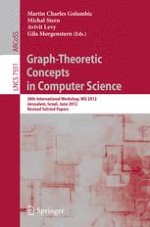This book constitutes the thoroughly refereed proceedings of the 38th International Workshop on Graph Theoretic Concepts in Computer Science (WG 2012) held in Jerusalem, Israel on June 26-28, 2012. The 29 revised full papers presented were carefully selected and reviewed from 78 submissions. The papers are solicited describing original results on all aspects of graph-theoretic concepts in Computer Science, e.g. structural graph theory, sequential, parallel, randomized, parameterized, and distributed graph and network algorithms and their complexity, graph grammars and graph rewriting systems, graph-based modeling, graph-drawing and layout, random graphs, diagram methods, and support of these concepts by suitable implementations. The scope of WG includes all applications of graph-theoretic concepts in Computer Science, including data structures, data bases, programming languages, computational geometry, tools for software construction, communications, computing on the web, models of the web and scale-free networks, mobile computing, concurrency, computer architectures, VLSI, artificial intelligence, graphics, CAD, operations research, and pattern recognition
